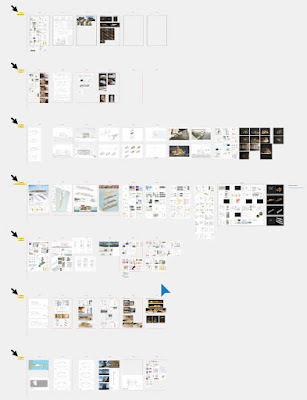Last week I had the opportunity to participate in Associate Professor Rahman Azari's Arch 431/491 end-of-semester design review at Penn State. This is the topic of today's post.
I was a juror for several student projects, each based on a similar program; a library on a pier along the Delaware River in Philly. The students developed thoughtful projects. Things like climate and neighborhood context, building performance, and native plant selections were included.
While I am not at liberty to share the student's work here, you can see in the Mural board below the highly graphic nature of the presentations. Lots of solid images and great renderings.
I was the only one participating remotely, but it was a surprisingly immersive experience. There were two cameras set up for me. One was in a chair among the other jurors, and another was set back, so I had a wide view, which included the project's physical model.
I was joined by three other jurors from the school...
- Alexandra Staub, Professor of Architecture
- Peter Aeschbacher, Associate Professor of Landscape Architecture and Architecture
Course Description:
The High-Performance Building (HPB) studio will explore the environmental sustainability dimensions of architectural design with a focus on museum building design. The objective is to design a 40,000 square-foot museum building with superior environmental performance on a site location in Philadelphia, PA. The studio is structured around 7 labs to explore various aspects of environmental sustainability. Emphasis will be on energy, daylighting, and life cycle environmental aspects of building performance.Your design will offer sustainable dynamic spaces that are environmentally friendly, contribute to the health and well-being of the occupants, and encourage collaborative learning and physical movement. The studio will rely on the AIA Framework for Design Excellence, COTE Top Ten Toolkit, Architecture 2030 targets, and Living Building Challenge as resources and guides. Student design proposals are developed in an iterative way involving research, design, analysis, and building performance simulation, redesign, re-evaluation.
Related:
For BIM Chapters updates, follow @DanStine_MN on Twitter or connect on LinkedIn
Lighting design professionals: check out my Revit & ElumTools training https://bit.ly/3NJjhCV



